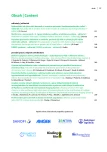Effective bowel preparation before coloscopy – low-volume PEG in the divided dose regimen
Authors:
Vladimír Kojecký 1; Milan Dastych 2; Zdena Zádorová 3; Michal Varga 1; Jan Hajer 3; Milan Kment 3; Radek Kroupa 2; Magda Kunovská 2; Jan Matouš 3; Miroslav Mišurec 1; Aleš Hep 2; Bohuslav Kianička 4; Jiří Latta 1
Authors‘ workplace:
Interní klinika Krajské nemocnice T. Bati a. s., Zlín
1; Interní gastroenterologická klinika LF MU a FN Brno, pracoviště Bohunice
2; II. interní klinika 3. LF UK a FN Královské Vinohrady, Praha
3; Gastroenterologické oddělení II. interní kliniky LF MU a FN u sv. Anny v Brně
4
Published in:
Vnitř Lék 2016; 62(4): 249-254
Category:
Original Contributions
Overview
Introduction:
The good and safe bowel cleansing is key to the success of coloscopy. The standard preparation involves 4 l polyethylene glycol (PEG). Now the combination of PEG and ascorbic acid (PEGA) of half the volume is available. Besides the type of product also the time factors which are not clarified, play a role during the bowel preparation. The aim of the study was to compare the efficiency and tolerance of both the agents and evaluate the effect of the time regimen of preparation.
Methods:
380 individuals were included in the evaluation in 4 cohorts which used 4 l PEG (Fortrans) in a single dose or split into 3 + 1 l and PEG + ascorbic acid (Moviprep) split into 1 + 1 l or 2 l one day before examination.
Results:
There was no difference between the agents as to the quality of bowel preparation, when they were used in the same regimen. The bowel cleansing was better in both cases in the divided dose regimen (p < 0.001), and it was inversely proportional to the length of preparation (p = 0.003) and directly proportional to the length of time between the end of preparation and coloscopy (p < 0.001). PEGA was better tolerated (p < 0.028), regardless of the preparation regimen.
Conclusion:
PEG and PEGA are similarly efficient in the bowel preparation before coloscopy provided they are used in a similar regimen. The best results are reached when the preparation is divided into 2 days. PEGA is better tolerated than PEG, regardless of the used regimen. The quality of bowel cleansing is affected by the length of preparation (optimally up to 12 hours) and the time elapsed from the preparation until examination (up to 8 hours).
Key words:
coloscopy – ascorbic acid – polyethylene glycol – preparation
Sources
1. Dastych M, Kroupa R. Možnosti endoskopického řešení polypoidních a nepolypoidních lézí v kolon. Vnitř Lék 2015; 61(7–8): 698–702.
2. Zádorová Z. Kolonoskopie. Doporučený postup endoskopického vyšetření tlustého střeva. Čes Slov Gastroent Hepatol 2005; 59(1): 26–30.
3. Moon CM, Park DI, Choe YG et al. Randomized trial of 2-L polyethylene glycol + ascorbic acid versus 4-L polyethylene glycol as bowel cleansing for colonoscopy in an optimal setting. J Gastroenterol Hepatol 2014; 29(6): 1223–1228.
4. Corporaal S, Kleibeuker JH, Koornstra JJ. Low-volume PEG plus ascorbic acid versus high-volume PEG as bowel preparation for colonoscopy. Scand J Gastroenterol 2010; 45(11): 1380–1386.
5. Hassan C, Bretthauer M, Kaminski MF et al. Bowel preparation for colonoscopy: European Society of Gastrointestinal Endoscopy (ESGE) guideline. Endoscopy 2013; 452(2): 142–150.
6. Ell C, Fischbach W, Bronisch HJ et al. Randomized trial of low-volume PEG solution versus standard PEG + electrolytes for bowel cleansing before colonoscopy. Am J Gastroenterol 2008; 103(4): 883–893.
7. Xie Q, Chen L, Zhao F et al. A meta-analysis of randomized controlled trials of low-volume polyethylene glycol plus ascorbic acid versus standard-volume polyethylene glycol solution as bowel preparations for colonoscopy. PLoS One 2014; 9(6): e99092. Dostupné z DOI: http://dx.doi.org/10.1371/journal.pone.0099092.
8. Kilgore TW, Abdinoor AA, Szary NM et al. Bowel preparation with split-dose polyethylene glycol before colonoscopy: a meta-analysis of randomized controlled trials. Gastrointest Endosc 2011; 73(6): 1240–1245
9. Huffman M, Unger RZ, Thatikonda C et al. Split-dose bowel preparation for colonoscopy and residual gastric fluid volume: an observational study. Gastrointest Endosc 2010; 72(3): 516–522.
10. Parra-Blanco A, Nicolas-Perez D, Gimeno-Garcia A et al. The timing of bowel preparation before colonoscopy determines the quality of cleansing, and is a significant factor contributing to the detection of flat lesions: a randomized study. World J Gastroenterol 2006; 12(38): 6161–6166.
11. Unger RZ, Amstutz SP, Seo DH et al. Willingness to undergo split-dose bowel preparation for colonoscopy and compliance with split-dose instructions. Dig Dis Sci 2010; 55(7): 2030–2034.
12. Eun CS, Han DS, Hyun YS et al. The timing of bowel preparation is more important than the timing of colonoscopy in determining the quality of bowel cleansing. Dig Dis Sci 2011; 56(2): 539–544.
13. Siddiqui AA, Yang K, Spechler SJ et al. Duration of the interval between the completion of bowel preparation and the start of colonoscopy predicts bowel-preparation quality. Gastrointest Endosc 2009; 69(3 Pt 2): 700–706.
14. Marmo R, Rotondano G, Riccio G et al. Effective bowel cleansing before colonoscopy: a randomized study of split-dosage versus non-split dosage regimens of high-volume versus low-volume polyethylene glycol solutions. Gastrointest Endosc 2010; 72(2): 313–320.
15. Seo EH, Kim TO, Park MJ et al. Optimal preparation-to-colonoscopy interval in split-dose PEG bowel preparation determines satisfactory bowel preparation quality: an observational prospective study. Gastrointest Endosc 2012; 75(3): 583–590.
16. Bryant RV, Schoeman SN, Schoeman MN. Shorter preparation to procedure interval for colonoscopy improves quality of bowel cleansing. Intern Med J 2013; 43(2): 162–168.
17. Aronchick CA. Bowel preparation scale. Gastrointest Endosc 2004; 60(6): 1037–1038.
Labels
Diabetology Endocrinology Internal medicineArticle was published in
Internal Medicine

2016 Issue 4
Most read in this issue
- DRESS syndrome
-
PCSK9 inhibitors – new possibilities in the treatment of hypercholesterolemia: For which patients will be indicated?
Czech atherosclerosis society statement - Beta-blockers and chronic obstructive pulmonary disease
- Chronic kidney diseases, metformin and lactic acidosis
